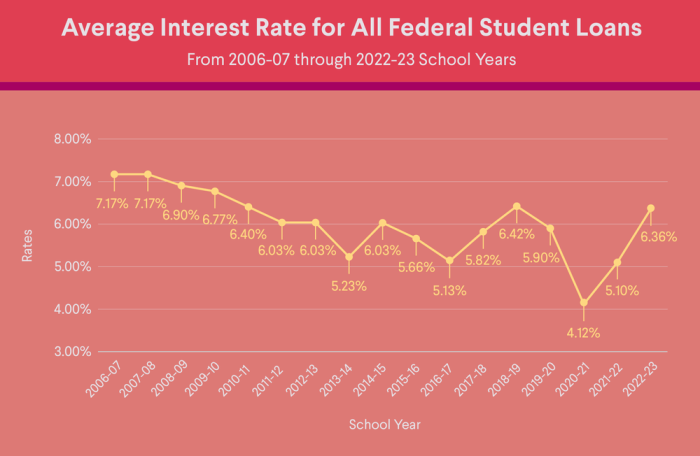
Navigating the complexities of student loan repayment can feel overwhelming, but understanding the potential tax benefits available can significantly ease the burden. This comprehensive guide explores the intricacies of writing off student loan interest, providing a clear path to potentially reducing your tax liability. We’ll delve into eligibility requirements, documentation needs, the tax form process, and even offer insights into potential future legislative changes. By the end, you’ll be equipped with the knowledge to confidently claim the deductions you deserve.
From understanding the different types of deductions and credits available to mastering the art of accurate record-keeping, we’ll cover every aspect of this often-overlooked tax advantage. We’ll compare various student loan repayment plans and their impact on your eligibility, offering practical examples to illustrate the potential savings. This guide aims to empower you to take control of your finances and maximize your tax benefits.
Eligibility for Writing Off Student Loan Interest

Writing off student loan interest can significantly reduce your tax burden, but understanding the eligibility requirements is crucial. This section details the available tax benefits, income limitations, and a step-by-step guide to help you determine if you qualify.
Student Loan Interest Deduction
The Student Loan Interest Deduction allows you to deduct the amount you paid in student loan interest during the tax year. This deduction is an above-the-line deduction, meaning it reduces your gross income before calculating your adjusted gross income (AGI). This makes it beneficial for taxpayers regardless of whether they itemize or take the standard deduction. The maximum deduction is $2,500 per tax year, regardless of how much interest you paid.
Income Limitations for the Student Loan Interest Deduction
To claim the student loan interest deduction, your modified adjusted gross income (MAGI) must be below a certain threshold. This threshold varies depending on your filing status. For the 2023 tax year, the phaseout begins at $80,000 for single filers and married filing separately, $160,000 for married filing jointly and qualifying surviving spouses, and $120,000 for heads of household. The deduction is gradually reduced as your MAGI approaches these limits and completely disappears once the limits are exceeded. It’s important to note that your MAGI is calculated differently than your AGI; certain deductions and adjustments are not considered when calculating MAGI.
Determining Eligibility for Writing Off Student Loan Interest: A Step-by-Step Guide
1. Gather your documents: Collect Form 1098-E, Student Loan Interest Statement, which shows the total amount of student loan interest you paid during the tax year. You will also need your tax return from the previous year to determine your MAGI.
2. Calculate your MAGI: Use your prior year’s tax return to find your MAGI. Remember that certain items are added back into AGI to arrive at MAGI. Consult IRS Publication 970 for a detailed explanation.
3. Check income limits: Compare your MAGI to the applicable limit for your filing status. If your MAGI is below the limit, you may be eligible for the deduction.
4. Determine your deduction amount: The deduction is the amount of student loan interest you paid, up to a maximum of $2,500. If your MAGI is above the threshold but below the phaseout range, the deduction will be reduced proportionally.
5. Claim the deduction on your tax return: Use Form 8863, Education Credits (American Opportunity and Lifetime Learning Credits), to claim the deduction.
Comparison of Student Loan Interest Deduction Options
| Feature | Student Loan Interest Deduction | Other Relevant Tax Benefits (If Applicable) |
|---|---|---|
| Type | Above-the-line deduction | May be combined with other education-related tax credits (depending on eligibility) |
| Maximum Deduction | $2,500 | Varies depending on the specific credit |
| Income Limits | Yes, phaseout begins at specific MAGI thresholds | Yes, income limitations often apply to tax credits |
| Filing Requirements | Form 8863 | Varies depending on the specific credit |
Documenting Student Loan Interest Payments

Proper documentation of student loan interest payments is crucial for successfully claiming the deduction. Maintaining accurate records not only simplifies the tax filing process but also protects you from potential penalties or audits should the IRS question your claim. This section will Artikel acceptable documentation, the importance of meticulous record-keeping, a sample record-keeping system, and the potential repercussions of inadequate documentation.
Acceptable Documentation for Student Loan Interest Payments
Acceptable documentation typically includes official statements from your loan servicer. These statements should clearly show the amount of interest paid during the tax year, the dates of the payments, and the loan identification number(s). Other acceptable forms of documentation might include canceled checks, bank statements showing loan interest payments, and payment confirmations received electronically from your lender. It’s essential that the documentation directly links the payment to the specific student loan for which you are claiming the deduction.
Importance of Accurate Record-Keeping
Keeping accurate records of your student loan payments and interest paid is paramount. The IRS requires detailed and verifiable proof to support any tax deductions claimed. Inaccurate or incomplete documentation can lead to delays in processing your tax return, the rejection of your deduction claim, and potentially penalties and interest charges. Furthermore, having organized records simplifies the process of preparing your taxes each year and minimizes the stress associated with tax season.
Sample Record-Keeping System for Tracking Student Loan Interest Payments
A simple and effective system for tracking student loan interest payments involves maintaining a dedicated spreadsheet or using personal finance software. The spreadsheet or software should include columns for the following information: Date of Payment, Payment Amount, Interest Paid (clearly distinguished from principal), Loan Identification Number, Payment Method (e.g., check, online transfer), and a Description (optional, but helpful for additional context). Regularly reconcile your records with your monthly statements from your loan servicer to ensure accuracy. An example entry might be: Date: 01/15/2024, Payment Amount: $250, Interest Paid: $100, Loan ID: 123456789, Payment Method: Online Transfer, Description: January Payment.
Potential Consequences of Inaccurate or Incomplete Documentation
Failure to provide sufficient documentation to support your student loan interest deduction claim can result in several negative consequences. The IRS might disallow your deduction, leading to a higher tax liability and potentially back taxes owed, along with interest and penalties. In some cases, an audit might be triggered, requiring you to provide further documentation and potentially incurring additional fees and legal costs. Maintaining thorough and accurate records is therefore a proactive measure to avoid these potential complications.
The Tax Form Process for Student Loan Interest Deduction
Claiming the student loan interest deduction can reduce your taxable income, resulting in a lower tax bill. This process involves using the correct tax form and accurately reporting your payments. Understanding the steps involved ensures a smooth and accurate filing.
The student loan interest deduction is claimed using Form 1040, Schedule 1 (Additional Income and Adjustments to Income). Specifically, you’ll use line 21, “Student loan interest.” This form allows you to itemize deductions, and if your itemized deductions exceed the standard deduction, you’ll benefit from claiming this deduction. Remember that the maximum deduction is $2,500, regardless of the amount you actually paid.
Form 1040, Schedule 1, Line 21: Student Loan Interest
To correctly complete this section, you need to gather your Form 1098-E, Student Loan Interest Statement. This form provides the total amount of student loan interest you paid during the tax year. You’ll enter this amount on Schedule 1, line 21. It’s crucial to ensure the amount matches your 1098-E; discrepancies can lead to delays or requests for further information from the IRS. If you paid interest on more than one student loan, the total from all forms should be combined before reporting.
Accurately Reporting Student Loan Interest Payments
Accurate reporting is paramount. Ensure you only include interest payments made on qualified education loans. This typically excludes loans used for purposes other than higher education. Additionally, double-check the payer’s name and the amount reported on your Form 1098-E to prevent errors. If you don’t receive a 1098-E, you can still claim the deduction, but you’ll need to maintain thorough records of your payments, including dates, amounts, and the lender’s name. This documentation will be crucial if the IRS requests verification.
Common Errors to Avoid When Completing the Tax Form
Several common mistakes can hinder the successful processing of your tax return. Avoiding these errors is crucial for a smooth filing process. Careless mistakes can lead to delays or even penalties.
- Incorrect Form Usage: Make sure you’re using the correct tax year’s Schedule 1 and entering the information on the designated line (line 21).
- Mismatched Amounts: Carefully compare the amount reported on your 1098-E with the amount you enter on your tax return. Any discrepancies need to be resolved.
- Including Non-Qualified Loans: Only include interest paid on qualified education loans. Interest paid on loans for other purposes is not deductible.
- Lack of Documentation: If you did not receive a 1098-E, retain all documentation proving your payments, including statements from your lender.
- Filing Without Itemizing: The student loan interest deduction is an itemized deduction. If your itemized deductions are less than your standard deduction, you won’t benefit from claiming this deduction.
Comparison of Student Loan Repayment Plans and Their Impact on Interest Deduction
Choosing the right student loan repayment plan significantly impacts your monthly payments and, consequently, the amount of interest you pay over the life of your loan. This, in turn, directly affects your eligibility for the student loan interest deduction. Understanding the nuances of different repayment plans is crucial for maximizing your tax benefits.
Different repayment plans structure your monthly payments differently, leading to variations in the total interest accrued and the timing of those payments. This variation directly influences the amount of interest you can deduct each year. For example, a plan with higher initial payments might lead to lower overall interest but potentially limit the amount you can deduct in the early years. Conversely, a plan with lower initial payments may allow for a larger deduction initially but result in paying more interest overall.
Standard Repayment Plan
The standard repayment plan involves fixed monthly payments over a 10-year period. This plan offers predictability in monthly expenses but may result in higher total interest payments compared to income-driven plans. The consistent monthly payments, however, simplify tax calculations for the student loan interest deduction, as the interest paid each year is relatively straightforward to track.
Income-Driven Repayment Plans
Income-driven repayment plans (IDR) adjust your monthly payments based on your income and family size. These plans typically extend the repayment period beyond 10 years, sometimes to 20 or even 25 years. While resulting in lower monthly payments, they often lead to higher total interest paid over the life of the loan. Tracking the interest paid for tax purposes can be more complex with IDR plans due to the fluctuating monthly payments and the potential for changes in income throughout the repayment period.
Comparison of Repayment Plans and Tax Benefits
The choice between a standard repayment plan and an income-driven repayment plan involves a trade-off between immediate financial relief and long-term interest costs and tax benefits.
- Standard Repayment Plan:
- Advantages: Predictable monthly payments, simpler interest deduction calculation, shorter repayment period.
- Disadvantages: Higher total interest paid, potentially higher monthly payments initially.
- Income-Driven Repayment Plan:
- Advantages: Lower monthly payments, potentially more manageable budget, potentially larger deductions in early years (depending on income and interest paid).
- Disadvantages: Higher total interest paid, more complex interest deduction calculation, longer repayment period.
For example, let’s consider two borrowers, both with $50,000 in student loan debt. Borrower A chooses a standard repayment plan, resulting in higher monthly payments but a total interest payment of $15,000 over 10 years. Borrower B opts for an income-driven plan, leading to lower monthly payments but a total interest payment of $25,000 over 20 years. While Borrower A pays less interest overall, Borrower B might benefit from lower monthly payments, potentially allowing them to save more and increase their tax deduction in the earlier years of repayment. The optimal choice depends heavily on individual financial circumstances and long-term goals.
Potential Changes in Student Loan Interest Deduction Laws
The student loan interest deduction, a valuable tax benefit for many borrowers, is not static. Changes in economic conditions, political priorities, and the overall landscape of higher education financing can all influence its future. Understanding potential alterations to this deduction is crucial for current and prospective borrowers to accurately plan their finances.
The student loan interest deduction, currently capped at $2,500, could face several potential changes. These range from adjustments to the deduction limit, modifications to eligibility requirements, or even its complete elimination. Such changes would significantly impact borrowers’ tax liabilities and overall repayment strategies.
Potential Adjustments to the Deduction Limit
The current $2,500 annual limit on the student loan interest deduction could be adjusted. A decrease would reduce the tax benefit for borrowers, potentially leading to higher after-tax repayment costs. Conversely, an increase could offer more substantial relief. For example, a hypothetical increase to $3,500 would provide an additional $1,000 in tax savings for those currently claiming the maximum deduction. This adjustment’s impact would be most pronounced for higher-income borrowers who are currently limited by the existing cap.
Changes to Eligibility Requirements
Modifications to eligibility criteria could also impact the deduction. Currently, adjusted gross income (AGI) limits exist. These limits could be lowered, making the deduction inaccessible to a larger segment of borrowers. Alternatively, the types of loans eligible for the deduction could be narrowed. For instance, the deduction might be restricted to only federal loans, excluding private student loans. This change would disproportionately affect borrowers with private loans, increasing their overall repayment burden.
Factors Influencing Future Legislation
Several factors could influence future legislation concerning the student loan interest deduction. The national debt, political priorities, and the overall state of the economy all play significant roles. For instance, during periods of fiscal conservatism, lawmakers might seek to reduce tax deductions to decrease the federal budget deficit. Conversely, periods of economic downturn might lead to an expansion of tax benefits aimed at stimulating consumer spending and supporting borrowers. Lobbying efforts by student advocacy groups and higher education institutions could also impact the future of this deduction. The rising cost of higher education and the increasing student loan debt burden are factors that could influence lawmakers to either maintain or even expand the deduction.
Illustrative Examples of Student Loan Interest Deduction Scenarios
Understanding the student loan interest deduction requires examining how it applies in various financial situations. The following scenarios illustrate the deduction’s impact on taxpayers with differing incomes and repayment plans. Remember that these are simplified examples and individual circumstances may vary. Always consult a tax professional for personalized advice.
High-Income Taxpayer with Standard Deduction
This scenario involves a high-income taxpayer, Sarah, who paid $2,500 in student loan interest during the tax year. Sarah’s modified adjusted gross income (MAGI) is $150,000, exceeding the phaseout threshold. The student loan interest deduction is subject to a phaseout for higher-income taxpayers. The phaseout begins at a certain MAGI and gradually reduces the deduction until it disappears entirely. The exact phaseout range depends on the filing status (single, married filing jointly, etc.) and the tax year. Let’s assume, for this example, the phaseout begins at $80,000 for single filers and is completely phased out by $100,000. Because Sarah’s MAGI exceeds $100,000, she cannot claim the student loan interest deduction. Therefore, her tax savings is $0.
Low-Income Taxpayer with Itemized Deductions
This scenario involves a low-income taxpayer, David, who paid $1,000 in student loan interest during the tax year. David’s MAGI is $40,000, and he itemizes his deductions. He is eligible for the full student loan interest deduction because his income is below the phaseout threshold. Assuming his total itemized deductions exceed his standard deduction, he can deduct the full $1,000. If his marginal tax rate is 12%, his tax savings will be $1,000 * 0.12 = $120.
Taxpayer with Income-Driven Repayment Plan
This scenario involves Emily, who is repaying her student loans under an income-driven repayment (IDR) plan. She paid $1,500 in student loan interest during the tax year. Her MAGI is $65,000. Because she’s below the phaseout threshold, she can deduct the full $1,500. However, the amount of interest paid under an IDR plan might be lower than under a standard repayment plan, potentially leading to a smaller deduction. Assuming Emily’s marginal tax rate is 22%, her tax savings will be $1,500 * 0.22 = $330. It is important to note that the type of repayment plan does not directly affect eligibility for the deduction, but it can indirectly influence the amount of interest paid and therefore the amount of the deduction.
Conclusive Thoughts

Successfully writing off student loan interest can provide substantial financial relief for borrowers. By diligently maintaining accurate records, understanding the relevant tax forms, and staying informed about potential legislative changes, you can effectively leverage this tax advantage. Remember, proactive planning and a thorough understanding of the process are key to maximizing your tax benefits and easing the financial pressures associated with student loan debt. Take the time to review your eligibility and claim what’s rightfully yours.
FAQ Guide
What if I don’t receive a 1098-E form?
You can still claim the deduction. Gather all your payment documentation from your lender and report the interest paid accordingly on your tax return.
Can I deduct interest paid on loans for graduate school?
Yes, as long as the loans were used to pay for qualified higher education expenses.
What happens if I overestimate the interest paid?
The IRS will adjust your return accordingly. It’s crucial to maintain accurate records to avoid potential issues.
Is there a limit to how much interest I can deduct?
Yes, the deduction is capped at $2,500 annually. Also, your modified adjusted gross income (MAGI) must be below a certain threshold. Consult the IRS guidelines for the most up-to-date limits.
